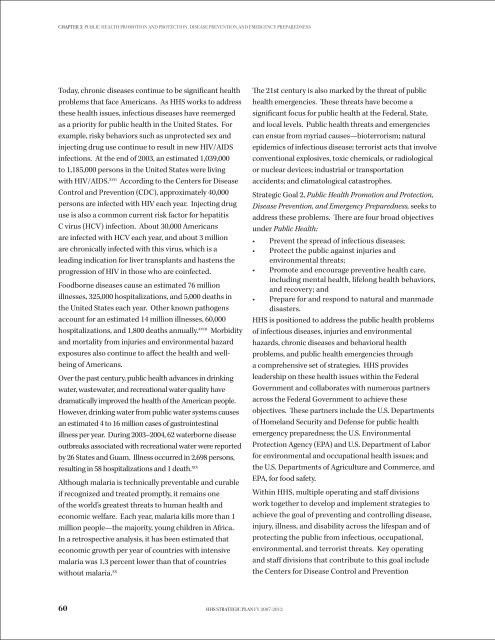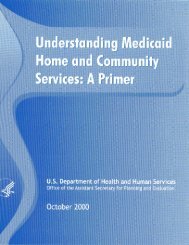STRATEGIC PLAN - ASPE - U.S. Department of Health and Human ...
STRATEGIC PLAN - ASPE - U.S. Department of Health and Human ...
STRATEGIC PLAN - ASPE - U.S. Department of Health and Human ...
Create successful ePaper yourself
Turn your PDF publications into a flip-book with our unique Google optimized e-Paper software.
CHAPTER 3: Public <strong>Health</strong> Promotion <strong>and</strong> Protection, Disease Prevention,<strong>and</strong> Emergency PreparednessToday, chronic diseases continue to be significant healthproblems that face Americans. As HHS works to addressthese health issues, infectious diseases have reemergedas a priority for public health in the United States. Forexample, risky behaviors such as unprotected sex <strong>and</strong>injecting drug use continue to result in new HIV/AIDSinfections. At the end <strong>of</strong> 2003, an estimated 1,039,000to 1,185,000 persons in the United States were livingwith HIV/AIDS. xvii According to the Centers for DiseaseControl <strong>and</strong> Prevention (CDC), approximately 40,000persons are infected with HIV each year. Injecting druguse is also a common current risk factor for hepatitisC virus (HCV) infection. About 30,000 Americansare infected with HCV each year, <strong>and</strong> about 3 millionare chronically infected with this virus, which is aleading indication for liver transplants <strong>and</strong> hastens theprogression <strong>of</strong> HIV in those who are coinfected.Foodborne diseases cause an estimated 76 millionillnesses, 325,000 hospitalizations, <strong>and</strong> 5,000 deaths inthe United States each year. Other known pathogensaccount for an estimated 14 million illnesses, 60,000hospitalizations, <strong>and</strong> 1,800 deaths annually. xviii Morbidity<strong>and</strong> mortality from injuries <strong>and</strong> environmental hazardexposures also continue to affect the health <strong>and</strong> wellbeing<strong>of</strong> Americans.Over the past century, public health advances in drinkingwater, wastewater, <strong>and</strong> recreational water quality havedramatically improved the health <strong>of</strong> the American people.However, drinking water from public water systems causesan estimated 4 to 16 million cases <strong>of</strong> gastrointestinalillness per year. During 2003–2004, 62 waterborne diseaseoutbreaks associated with recreational water were reportedby 26 States <strong>and</strong> Guam. Illness occurred in 2,698 persons,resulting in 58 hospitalizations <strong>and</strong> 1 death. xixAlthough malaria is technically preventable <strong>and</strong> curableif recognized <strong>and</strong> treated promptly, it remains one<strong>of</strong> the world’s greatest threats to human health <strong>and</strong>economic welfare. Each year, malaria kills more than 1million people—the majority, young children in Africa.In a retrospective analysis, it has been estimated thateconomic growth per year <strong>of</strong> countries with intensivemalaria was 1.3 percent lower than that <strong>of</strong> countrieswithout malaria. xxThe 21st century is also marked by the threat <strong>of</strong> publichealth emergencies. These threats have become asignificant focus for public health at the Federal, State,<strong>and</strong> local levels. Public health threats <strong>and</strong> emergenciescan ensue from myriad causes—bioterrorism; naturalepidemics <strong>of</strong> infectious disease; terrorist acts that involveconventional explosives, toxic chemicals, or radiologicalor nuclear devices; industrial or transportationaccidents; <strong>and</strong> climatological catastrophes.Strategic Goal 2, Public <strong>Health</strong> Promotion <strong>and</strong> Protection,Disease Prevention, <strong>and</strong> Emergency Preparedness, seeks toaddress these problems. There are four broad objectivesunder Public <strong>Health</strong>:• Prevent the spread <strong>of</strong> infectious diseases;• Protect the public against injuries <strong>and</strong>environmental threats;• Promote <strong>and</strong> encourage preventive health care,including mental health, lifelong health behaviors,<strong>and</strong> recovery; <strong>and</strong>• Prepare for <strong>and</strong> respond to natural <strong>and</strong> manmadedisasters.HHS is positioned to address the public health problems<strong>of</strong> infectious diseases, injuries <strong>and</strong> environmentalhazards, chronic diseases <strong>and</strong> behavioral healthproblems, <strong>and</strong> public health emergencies througha comprehensive set <strong>of</strong> strategies. HHS providesleadership on these health issues within the FederalGovernment <strong>and</strong> collaborates with numerous partnersacross the Federal Government to achieve theseobjectives. These partners include the U.S. <strong>Department</strong>s<strong>of</strong> Homel<strong>and</strong> Security <strong>and</strong> Defense for public healthemergency preparedness; the U.S. EnvironmentalProtection Agency (EPA) <strong>and</strong> U.S. <strong>Department</strong> <strong>of</strong> Laborfor environmental <strong>and</strong> occupational health issues; <strong>and</strong>the U.S. <strong>Department</strong>s <strong>of</strong> Agriculture <strong>and</strong> Commerce, <strong>and</strong>EPA, for food safety.Within HHS, multiple operating <strong>and</strong> staff divisionswork together to develop <strong>and</strong> implement strategies toachieve the goal <strong>of</strong> preventing <strong>and</strong> controlling disease,injury, illness, <strong>and</strong> disability across the lifespan <strong>and</strong> <strong>of</strong>protecting the public from infectious, occupational,environmental, <strong>and</strong> terrorist threats. Key operating<strong>and</strong> staff divisions that contribute to this goal includethe Centers for Disease Control <strong>and</strong> Prevention60 HHS Strategic Plan FY 2007-2012
















